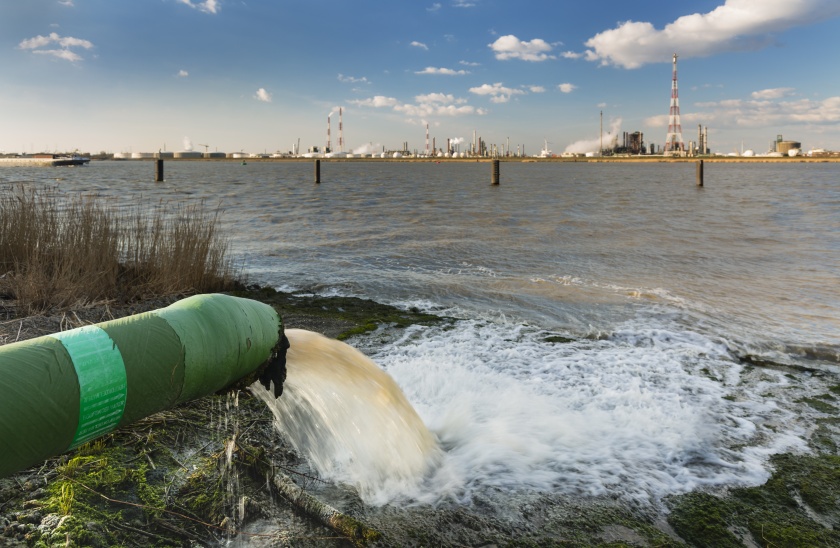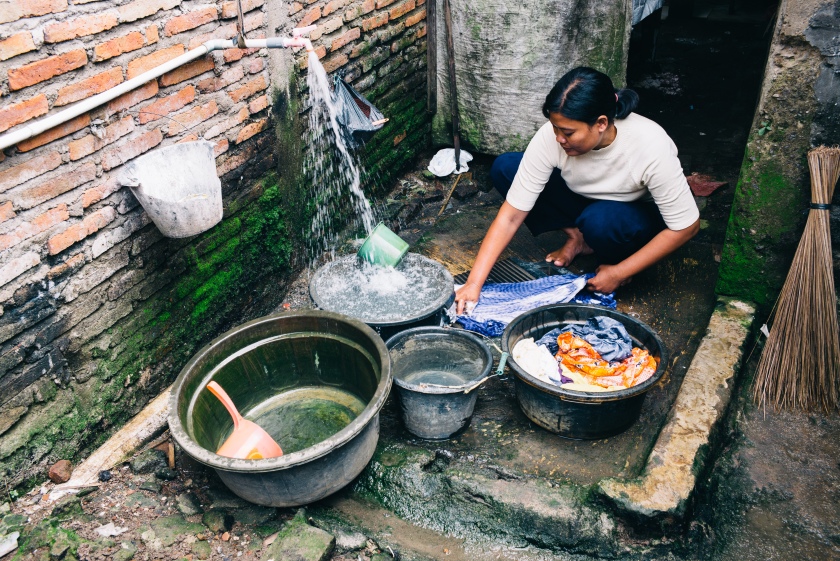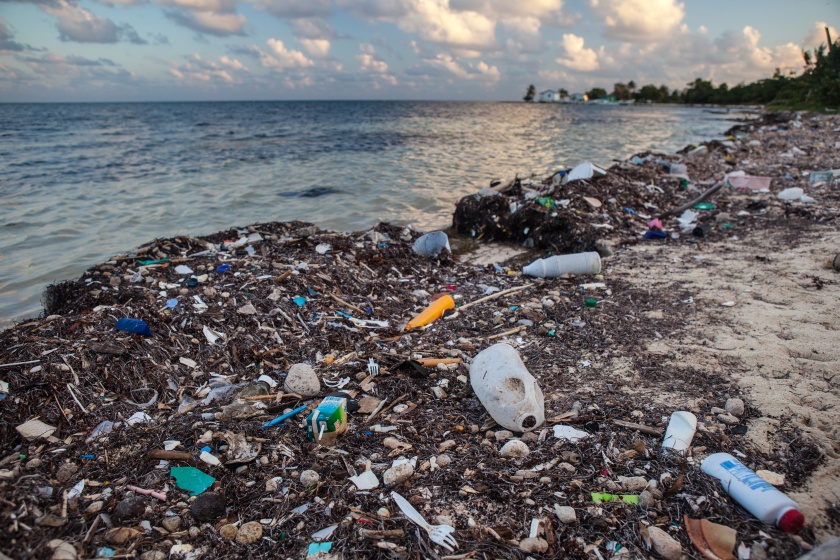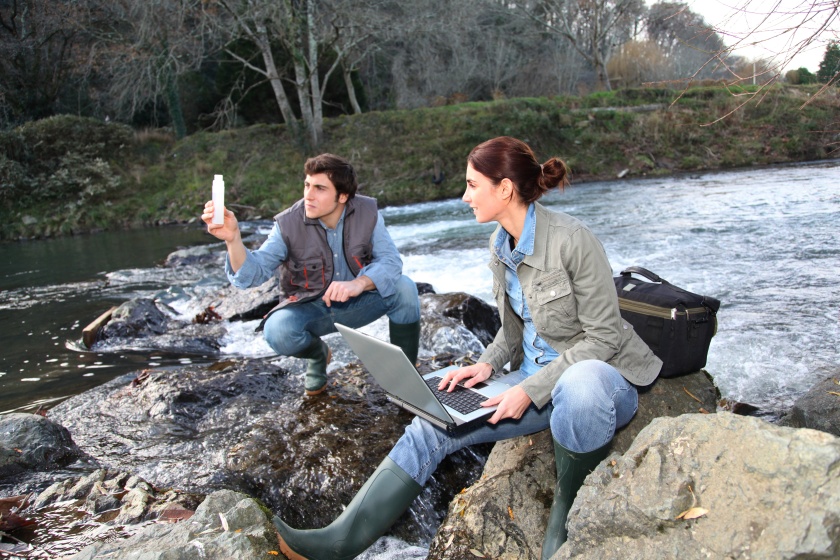By Star Noor
Photography: Stock Images, water.org
FIRST PUBLISHED IN COCO ECO MAGAZINE, ISSUE 32, 2015

A wastewater pipe and a large oil refinery in the harbor of Antwerp, Belgium with blue sky and warm evening light.
If we are what we consume, then we are what we drink, and what our food eats and drinks. With much of the news about water shortage in the U.S. being largely centered around California these days, it seems that somehow a severe and broad crisis has been reduced and contained to the West Coast of the United States—that is, when it is actually getting media coverage. In the broader sense our problem nets much wider, touching all American lives and the lives of billions the world-over.
We all know without water there is no survival, yet the depth of how little drinking water we have left due to over-usage, droughts and pollution, and what this means in terms of human health and quality of life is still unclear. By last report to the United Nations, 1.1 billion people do not have access to improved drinking water. In the United States (U.S.) 9 states are currently experiencing water shortage, and by 2050 it is estimated that all U.S. states will be in crisis.
As water depletes and pollution increases, our populace will soon face the day-to-day challenge that over a billion face every day in other parts of the world—acquiring access to clean water. The lack thereof can lead to an array of health and nutritional problems as currently demonstrated in drought ravaged, war-torn nations around the world. Xenobiotics, pathogens, algae, heavy metals, radioactive minerals, and other contaminants along with natural dry spells aid in the deaths of 3.4 million people per year worldwide (as reported by the World Heath Organization in a 2009 study). Millions are hospitalized due to waterborne illnesses as a result from the lack of access to clean drinking water—a cornucopia ranging from sever bowl irritations to kidney and liver damage, to typhoid and neurological problems, to cancer and even to death, just to name a few.

Water pollution is by far the most important environmental crisis we face today, as water is the life bearer of our entire eco-system. Today, we have 80,000 known contaminants, eighteen of which are not regulated under the Federal Safe Drinking Water Act (SDWA) and were found in over 1/3 of U.S. cities participating in a voluntary study in 2013 by the researchers from the Geological Survey and the Environmental Protection Agency. Of this total, only 5 of these contaminants are even ranked by the EPA, some with acceptable standards far greater than the recommended amounts for human consumption suggested by independent researchers. According to officials at the U.S. EPA:
“When the Toxic Substances Control Act (TSCA) was enacted, it grandfathered in, without any evaluation, about 60,000 chemicals that were in commerce at the time. The statute did not provide adequate authority for the EPA to reevaluate these existing chemicals as new concerns arose or science was updated. The law also failed to grant the EPA effective tools to compel companies to generate and provide toxicity data.”
Water contaminants can occur naturally, but most are the result of agricultural and industrial run-off, faulty waste lagoons which can leak into the ground, direct contact of livestock with open waters, incorrect disposal of medications, the use of harmful pesticides, and poor garbage disposal methods. The most troubling of these are hexavalent chromium, glyphosate, radium, mercury, and plastic waste contaminants which poison marine life, livestock, produce, drinking water, and by way of consumption, us.
Some may remember the movie Erin Brokovich (2000), which brought to light hexavalent chromium and the tragedy of Hinkley, California. While some may have never heard of it, the film based on the journey of Brokovich and her colleagues in the lawsuit against Pacific Gas and Electric Company (PG&E) is what definitively brought acute mainstream attention to hexavalent chromium, also known as chromium 6—found in 2,475 California water sources alone. According to Occupational Safety & Heath Administration (OSHA), chromium 6 can cause pulmonary congestion and edema, liver and kidney damage, lung cancer, and leukemia. Currently hexavalent chromium does not have a unique standard set by the Environmental Protection Authority (EPA) and is only included in the standards for all chromium. Interestingly, 15 years after the movie, the sleepytown of Hinkley is still not free of this contaminant, and California has just recently set a standard for the chemical, over a decade past the legal deadline set by SB351, passed in 2001.
In the U.S., hexavalent chromium has been found in 25 cities tested by the Environmental Working Group. Still, the EPA has not taken decisive action, and although pollutants in waterways also dually contaminate us by poisoning our food supplies, the Food and Drug Administration (FDA) has not yet set standards for chromium 6 either.
Glyphosate, the key component of RoundUp® (brought to you by the creators of Agent Orange), is one such agricultural contaminant that packs a one-two-three punch. Monsanto’s genetically modified glyphosate resistant seeds are planted worldwide. RoundUp® resistant plants are additionally contaminated during the growth process when watered with polluted water, containing contaminants from runoff of agricultural pollutants that find their way into our waterways more and more with every passing year. Talk about a triple threat.
The 2011 U.S. Geological Survey (USGS) Technical Announcement reported that “RoundUp® is used in all agricultural areas, but is most persistent in the Mississippi watershed where most applications are for weed control for genetically modified corn.” RoundUp® use exploded from 49,000 tons in 2002 to 128,000 tons in 2012. Glyphosate blocks gene receptors that help create enzymes, which help form and breakdown molecules that are essential for the normal functioning of our various biological systems. It has been linked to weight gain, depression, Alzheimer’s, kidney disease, cancer, and reproductive difficulties. Regardless of a multitude of credible independent studies the FDA site only issues an industry linked study by Pioneer, a Dupont Company, which states: “No single factor has been sourced as the primary indicator of allergenic potential, and no validated animal model that is predicative is available.”
Similarly, the EPA seems to have their heads in the sand. According to the EPA, “Maximum Contaminant Level Goal” (MCLG) for glyphosate is 700 ppb (parts per billion) while independent suggestions stand at much lower levels. The problem with regulatory testing is that they are not only industry sponsored but also geared towards testing only the “active ingredient” glyphosate. However, studies have found that RoundUp® and other commercial glyphosate herbicide formulations are far more toxic than the isolated glyphosate which is logical considering the added ingredients called “adjuvants” that are added specifically to increase toxicity. Furthermore, no long-term testing had been conducted for RoundUp® or other formulations prior to release on the market. According to officials at the U.S. EPA, “TSCA clearly needs improvement. The lack of deadlines, the ability to require needed data and burdensome regulatory standard have made it difficult for the EPA to ensure the American public that the chemicals used in the products they and their families use are safe.”
Radium, mercury, pharmaceutical residue and plastic contaminants from waste pollution such as dioxin and vinyl chloride further ravage our water systems. The ocean stands separate from our drinking water, but is not alien to our state of health. Much has been made of high levels of mercury in fish, particularly in shark, swordfish, king mackerel, and tilefish— though most recently the record die-off of oysters and scallops due to a rare form of leukemia believed to be caused by the radiation fall-out from Fukushima has also garnered concern as ocean chemistry becomes increasingly acidic. By 2040, if current practices persist, scientists believe the oceans may become barren.
Plastic contaminants enter the marine eco-system due to human negligence. As our archaic waste management practices become more and more imposing upon our natural systems, and as human consumption aggregates growth of plastic production we are seeing a sharp increase in plastic pollutants in ocean waters all across the world—560 fold in over just 60 years. This plastic, over time, degenerates into smaller pieces and resemble commercial fish food. Fish then consume these pieces thereby polluting their biological systems. Through the consumption of smaller fish by bigger fish, and then them by us, we too are contaminated. As the threat to the global oceanic environment continues to grow and large die-offs occur our oceanic aquaculture become threatened, which is a staple that millions, especially in poor nations, are dependent upon. Therefore, through our own aquatic assault, we are delivering yet another death blow to human health and survival.

A further problem actually propelling our water crisis is the bottled water industry. Bottled water standards are set by the FDA, however testing is done by the companies themselves and they are rare. To get information on chromium levels in bottled water you must contact the manufacturing companies, and many are pumping water out of public waterways, even directly utilizing tap water which is then marketed as spring or glacier water. This act is not only deceptive to the public, but also extensively depletes public water. Companies like Nestlé® are making record profits paying only pennies on the dollar even in areas ravaged by water crisis, such as California. Faulty industry-favoring regulations allow this with no suitable explanation.
So in the end of all of this, where do our environmental and health agencies stand? We know that the EPA has no current standard for chromium 6, however, they did recently reclassify glyphosate in the 2a category; meaning that it’s classified as a “possibly harmful.” And, in March the WHO’s cancer research agency—International Agency for Research on Cancer (IARC)—classified glyphosate as possibly cancer-causing (stated in a paper published in Lanclet Oncology).
“Though glyphosate is the most widely used herbicide we know very little about its long-term effects,” said Paul Capel, the author of the 2011 USGS study.

Biologists testing water of natural river
Solutions are available. Organizations, like Water for People (WFP), are hard at work in countries most hard hit with lack of drinking water where they are utilizing the ingenuity of the people to provide long-term solutions. “Since 2006 WFP turned away from “popcorn” projects and helped design water and sanitation solutions that local authorities, local entrepreneurs, and communities can afford, manage, and sustain,” states the WFP. Some of these solutions include projects in water recycling and gathering rainwater for reuse. In much the same vein, scientists at University of Technology and Engineering (UTEC) have created billboards which collect atmospheric condensation and filters it to be drinkable water, currently available for free to the people of Peru. Similarly, the methods of ozone oxidation can provide an effective way for people around the world to achieve safe water availability in their communities. Further, the amendment of policy holds hope for change, if our policy makers manage to do the right thing for our environment and the people, and push to enforce said future amendments.
Currently, HR.1422, EPA Science Advisory Board Reform Act 2014, sponsored by Representative Chris Stewart (R-UT) has passed the House. Critics of the reform claim that it is geared in favor of industry rather than accurate science, which helps keep the people safe. The Act is said to restrict scientists of studies to advise the EPA in any way as to their own research, while industry paid scientists are free to give their findings to the EPA. However, when we spoke to the U.S. EPA they stated, “We are pleased with the ongoing efforts in the House and the Senate to reform Toxic Substances Control Act (TSCA), which seek to address the goals spelled out in the Administration’s Principles. We look forward to working with Congress to send strong TSCA reform legislation for the President to sign.”
In that, you have to wonder if someday the President (whoever it might be), will begin to hold the corporate polluters culpable and accountable for billions of dollars to help correct what they helped create. We must ask ourselves, companies that flush chemical waste into our natural waterways, companies that knowingly use chemicals that are harmful, yet spend millions to offset their damage by saving face through public relations,
politicians who simply turn a blind eye or help aid and abide criminals, and those who steal our natural resources only to sell it back to us at a higher price—should not they pay for what they knowingly do? More and more people are saying yes.
It is not a utopian dream to want a better world. Even if a Thomas More-esque utopia might be out of reach or even an implausible anti-progressive dysfunctional bliss, human beings everywhere have a superlative right for the pursuit of happiness and progression. Wanting unpolluted air, clean water, un-poisoned naturally-sound food, clean architecture and industries, which leave less of our dirty footprints on our planet—these are our just rights as are the rights of corporate entities and governments to exist and create profit. Wanting a better world, nay, demanding it, is not socialist, communist, or liberal capitalist; it is not the summation of parts for an unreachable world but the summation of the human experience. The rights to evolve, to ask questions and pursue true answers; to propel ourselves and write the condition of our future generations—these are the human condition. Our need for fairly available clean water is not just a biological one but an imperative and ever running pursuit of human progress in that we must take personal action to protect ourselves and each other, to ask the questions others do not want to answer, and to insist on doing things better for everyone, from everyone.






